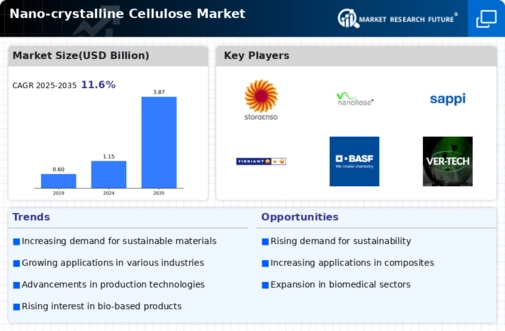Market Growth Projections
The Global Nano-crystalline Cellulose Market Industry is projected to experience robust growth in the coming years. With a market value expected to reach 1.15 USD Billion in 2024 and further expand to 3.87 USD Billion by 2035, the industry is poised for significant development. The anticipated compound annual growth rate (CAGR) of 11.67% from 2025 to 2035 underscores the increasing adoption of nano-crystalline cellulose across various sectors. This growth trajectory reflects the material's versatility and the rising demand for sustainable solutions, positioning it as a critical component in the future of materials science.
Advancements in Nanotechnology
Technological advancements in nanotechnology significantly influence the Global Nano-crystalline Cellulose Market Industry. Innovations in production techniques and applications enhance the properties of nano-crystalline cellulose, making it more versatile for various uses. For instance, improvements in extraction methods lead to higher purity and yield, which are crucial for industries such as pharmaceuticals and food additives. The ability to manipulate materials at the nanoscale allows for the development of high-performance composites and coatings. As these advancements continue, the market is expected to grow, with projections indicating a rise to 3.87 USD Billion by 2035, demonstrating the potential of nanotechnology in driving market expansion.
Rising Demand for Sustainable Materials
The Global Nano-crystalline Cellulose Market Industry experiences a notable increase in demand for sustainable materials across various sectors. Industries such as packaging, automotive, and construction are increasingly seeking eco-friendly alternatives to traditional materials. Nano-crystalline cellulose, derived from renewable resources, offers a biodegradable and non-toxic option that aligns with global sustainability goals. As consumers and manufacturers prioritize environmental responsibility, the market is projected to reach 1.15 USD Billion in 2024, reflecting a growing trend towards sustainable practices. This shift not only supports environmental initiatives but also enhances product performance, making nano-crystalline cellulose a preferred choice for innovative applications.
Growing Applications in the Food Industry
The Global Nano-crystalline Cellulose Market Industry sees a surge in applications within the food sector, driven by the need for natural additives and stabilizers. Nano-crystalline cellulose serves as a thickening agent, emulsifier, and texturizer, enhancing the quality and shelf life of food products. With increasing consumer awareness regarding food safety and health, manufacturers are turning to natural alternatives to synthetic additives. This trend is likely to bolster market growth, as the food industry increasingly adopts nano-crystalline cellulose for its functional benefits. The anticipated growth in this sector contributes to the overall market expansion, aligning with the projected CAGR of 11.67% from 2025 to 2035.
Regulatory Support for Biodegradable Materials
The Global Nano-crystalline Cellulose Market Industry benefits from increasing regulatory support for biodegradable materials. Governments worldwide are implementing policies that promote the use of sustainable and environmentally friendly materials in various applications. This regulatory framework encourages industries to adopt nano-crystalline cellulose as a viable alternative to conventional plastics and synthetic materials. As regulations tighten around waste management and environmental impact, the demand for biodegradable solutions is expected to rise. This shift not only aligns with global sustainability goals but also positions nano-crystalline cellulose as a key player in the transition towards a circular economy.
Increased Investment in Research and Development
Investment in research and development plays a crucial role in the Global Nano-crystalline Cellulose Market Industry. Governments and private entities are allocating resources to explore new applications and improve production methods for nano-crystalline cellulose. This focus on R&D fosters innovation, leading to the discovery of novel uses in sectors such as biomedical engineering, electronics, and renewable energy. Enhanced funding for research initiatives not only accelerates technological advancements but also encourages collaboration among academic institutions and industry players. As a result, the market is poised for growth, with the potential for new applications to emerge, further driving demand for nano-crystalline cellulose.











